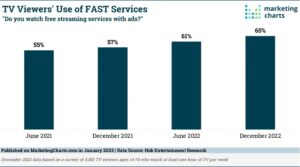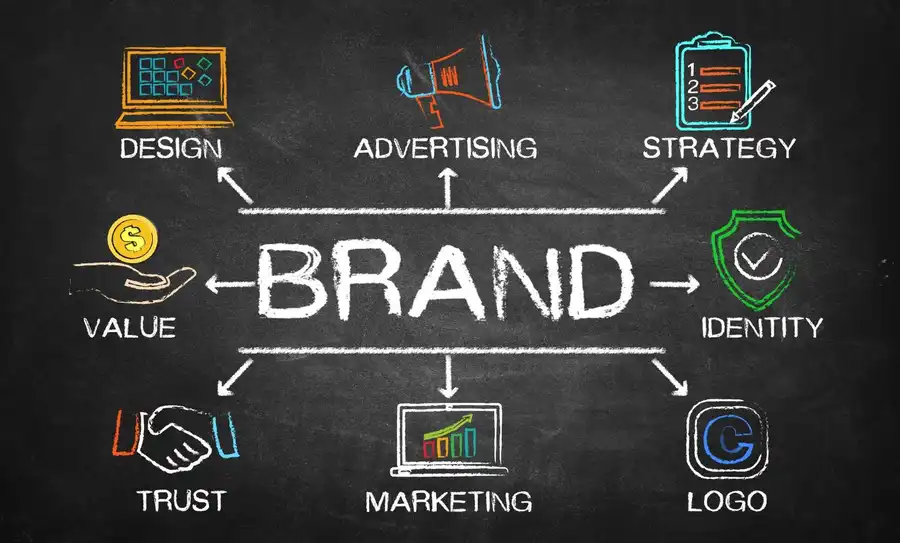In this blog post, we’ll dive into the world of OTT advertising campaign planning and share some best practices and tips to help you create an effective campaign that reaches your target audience on this exciting platform.
The Shift to Free Ad Supported TV (Fast Services)
With many people cutting back on expenses such as cable subscriptions, ad-supported streaming services offer a more affordable and flexible alternative to TV. Ad-supported streaming services provide a higher value to viewers who are looking to save time and money without compromising on quality. These services are growing at a faster pace than subscription-based services as advertisers capitalize on larger and more engaged audiences, delivering relevant and targeted ads that elicit positive responses from viewers.
According to a study from Kantar, in December 2022, 65% of individuals aged 14-74 watched ad-supported TV, growing from just 55% in June of 2021.

With streaming content increasingly becoming part of consumers’ daily habits, businesses can seize this opportunity to leverage ad-supported streaming services, instead of or in addition to TV advertising, and reach a broad audience while maintaining advertising efficiency.
Establish Realistic OTT Advertising Goals
Developing a well-defined advertising plan and setting realistic expectations for success is crucial when testing a new advertising channel.
A well-defined advertising plan helps businesses to determine precisely who their target audience is, choose the most effective ad formats and creative strategies, and set realistic goals anchored in their marketing objective. Having this plan in place allows businesses to measure the campaign’s effectiveness more accurately and determine areas for optimization.
It’s also essential to set realistic expectations for success when testing a new advertising channel to avoid disappointment and frustration. New advertising channels may require more time, testing, and optimization than expected to gain traction and produce meaningful results. With a clear and realistic plan in place, businesses can effectively navigate the challenges of testing a new advertising channel, optimize their campaigns, and ultimately build a robust and effective advertising strategy.
Understand Your Target Audience
To create an effective OTT campaign, it’s important to gain insight into the interests and behaviors of the target audience. If you have developed buyer personas, use them. If not, advertisers should identify their ideal customer type and begin to research information such as demographics, viewing habits, consumer preferences, and other relevant factors.
The flexibility of OTT ads allows marketers to choose from a variety of streaming services and device types, including:
- Smart TVs
- Digital Streaming Boxes
- Game Consoles
- Mobile Devices
By selecting the right OTT platforms and channels for their target audience, businesses can increase the chances of delivering their message to the right person at the right time, resulting in better ROI and ad campaign results.
Determine Your Media Channel Mix
Determine what other media channels are supporting the campaign, such as:
- Radio
- Out-of-Home
- Linear TV
- Display
- Paid Social
- Search
Understanding how OTT plays into your advertising mix and its key performance indicators is critical to ensuring successful campaign outcomes. Key KPIs may include reach and frequency, video completion rate, web/foot traffic and more. By understanding how all these pieces fit together, businesses can make informed decisions about their OTT campaigns and ensure they are successful in reaching their desired audiences with effective messages.
Establish a Target Geography
Target geography is crucial for an OTT campaign because it helps businesses to deliver customized content and advertising messages to audiences in specific regions. By targeting specific regions or locations, businesses can fine-tune their advertising efforts to account for local trends, culture, and other factors that may affect user behavior.
Additionally, targeting specific regions can help businesses to better control advertising spend, as it can reduce the number of impressions served to users who are unlikely to visit a business or make a purchase.
Set Campaign Parameters
When developing an OTT campaign, it’s important to consider various factors such as flight dates, budgets, and testing within the parameters of the campaign’s objectives.
Flight dates refer to the specific duration that an ad campaign will run, typically ranging from weeks to months. These dates should be determined based on the goals and objectives of the overall marketing strategy.
- Budget
The budget, or ad spend, allocated for the OTT campaigns should be realistic and feasible. The budget should be distributed into distinct sections to be utilized for specific purposes, including ad placement, creative production, testing, and analysis. - A/B Testing
A/B testing, which is a type of test where two different versions of an ad are shown simultaneously to determine which performs better, can be used to determine which creatives, audience segments, or bidding strategies result in higher conversion rates.
By setting clear and defined parameters for the OTT campaign, marketers can optimize the effectiveness of their campaigns and maximize return on investment.
Measure OTT Ad Campaign Success
Proving the effectiveness of OTT ad campaigns can present some challenges for advertisers. One of the primary challenges is measuring OTTs impact on brand awareness metrics such as brand recognition and purchase intent. Additionally, unlike other forms of digital advertising, OTT ads typically do not feature direct response CTAs, which can make it harder to accurately attribute conversions and ROI to specific campaigns.
However, advertisers can address these challenges by leveraging advanced analytics and metrics that can provide a better understanding of which aspects of the campaign are performing well and the impact of the OTT advertising on overall business outcomes.
Common metrics that are readily available for measuring the success of OTT campaigns include performance metrics, such as:
- Household Reach & Frequency
How many unique households were exposed to your OTT advertisement and how often did it play on a device within the home. - Video Completion Rate
Completion rates measure the percentage of viewers who watched the entire video ad. - Cost per Completed View (CPV)
CPV measure the cost for a completed view. - Cost per Mille (CPM)
CPMs measure the cost to deliver 1,000 impressions. - View Thru Conversion Rates
Track the percentage of viewers who take a desired action, such as making a purchase or filling out a form after being exposed to an OTT advertisement.
By analyzing these metrics, businesses can identify areas of success, areas where optimization is needed, and make informed decisions to ensure their campaigns perform optimally.
Getting Started with OTT Campaign Planning
If you’re interested in getting started with OTT advertising, schedule a free consultation with our team. Together we can develop a plan that will drive growth for your business.











